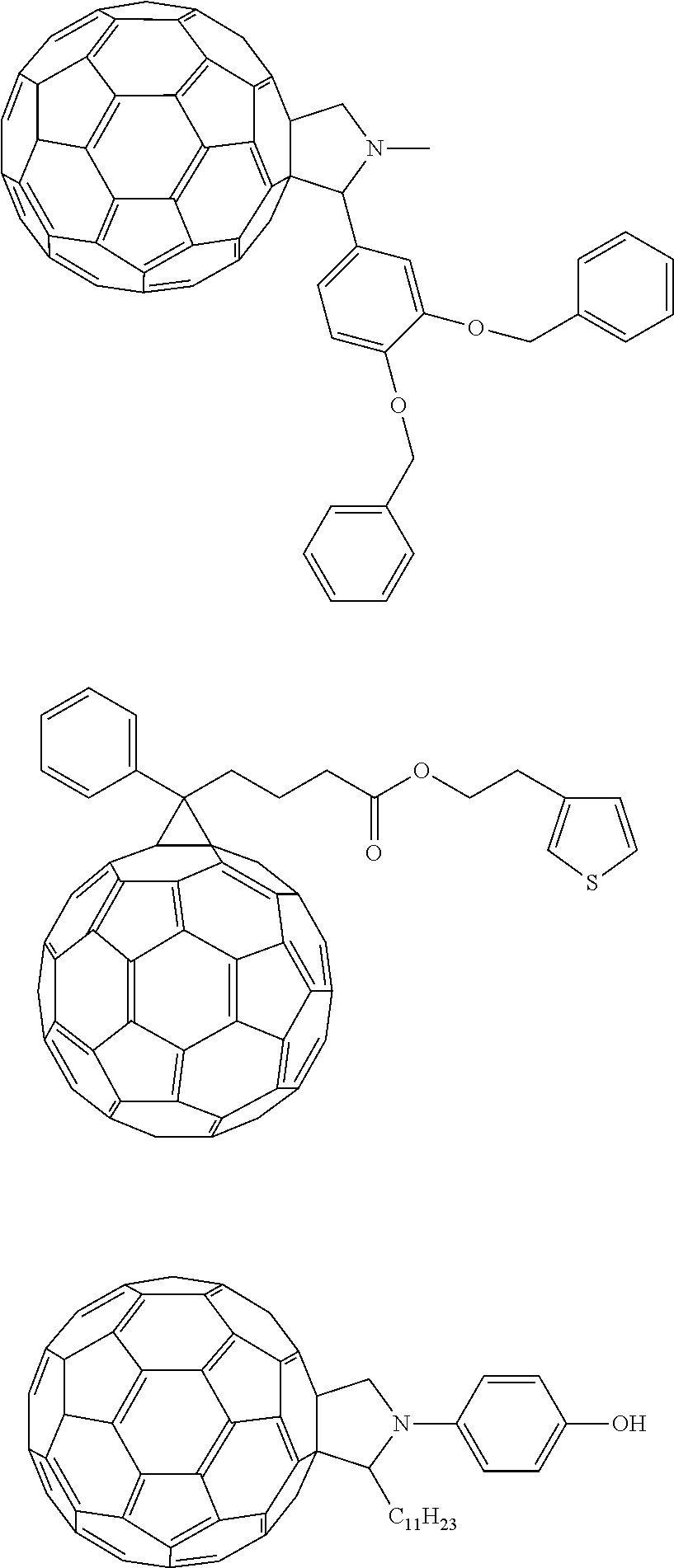Organic photoelectric conversion element and production method thereof
a photoelectric conversion element and organic technology, applied in the field of organic photoelectric conversion elements, can solve the problems of insufficient photoelectric conversion efficiency of the photoelectric conversion element provided with the anode formed by the use of pedot/pss, and achieve the effect of high photoelectric conversion efficiency and easy formation
- Summary
- Abstract
- Description
- Claims
- Application Information
AI Technical Summary
Benefits of technology
Problems solved by technology
Method used
Image
Examples
synthesis example 1
Synthesis of Polymer 1
[0058]
[0059]7.928 g (16.72 mmol) of the compound (A), 13.00 g (17.60 mmol) of the compound (B), 4.979 g of methyltrioctylammonium chloride (trade name: aliquat 336, manufactured by Aldrich Chemical Company, Inc., CH3N [(CH2)7CH3]3Cl, density 0.884 g / ml at 25° C., trademark of Henkel Corporation), and 405 ml of toluene were put in a 2 liter four-necked flask, the inside of which was replaced with an argon gas, and the inside of a system was bubbled for 30 minutes with an argon gas while being stirred to be aerated. To this, 0.02 g of dichlorobis (triphenylphosphine) palladium (II) was added, and to the resulting mixture, 42.2 ml of a 2 mol / L aqueous solution of sodium carbonate was added dropwise while heating at 105° C. and stirring the mixture. After the completion of adding dropwise, the mixture was reacted for 5 hours, and 2.6 g of phenylboronic acid and 1.8 ml of toluene were added and the resulting mixture was stirred at 105° C. for 16 hours. 700 ml of tol...
example 1
Preparation of Organic Thin Film Solar Cell
[0061]An anode composed of polyaniline was formed by applying a polyaniline solution (ORMECON D 1033 W (water solvent) manufactured by Nissan Chemical Industries Co., Ltd.) onto a glass substrate and then heating the solution at 100° C. for 10 minutes in the atmosphere. The film thickness of polyaniline was about 130 nm. The anode composed of the polyaniline was transparent.
[0062]Next, the composition 1 was applied onto the anode by spin coating to obtain an active layer (film thickness about 100 nm). Thereafter, the active layer was dried under a reduced pressure for one hour, and by vapor deposition, lithium fluoride was deposited in a thickness of 4 nm as a cathode buffer layer, and as a cathode, calcium was deposited in a thickness of 5 nm and then aluminum was deposited in a thickness of 100 nm to prepare an organic photoelectric conversion element. A degree of vacuum at the time of vapor deposition was always 1×10−4 to 9×10−4 Pa.
example 2
Preparation of Organic Thin Film Solar Cell
[0063]An anode composed of polyaniline was formed by applying a polyaniline solution (ORMECON D 1033 W (water solvent) manufactured by Nissan Chemical Industries Co., Ltd.) onto a glass substrate and then heating the solution at 100° C. for 10 minutes in the atmosphere. The film thickness of polyaniline was about 130 nm. The anode composed of the polyaniline was transparent. The film thickness of polyaniline was about 130 nm. The anode composed of the polyaniline was transparent. Thereafter, a HIL 691 solution (manufactured by Plextronics, Inc., trade name Plexcore HIL 691) was applied onto the anode by spin coating to obtain a hole transport layer (film thickness about 100 nm) which is a functional layer. The HIL 691 solution was measured with a pH test paper (manufactured by Advantec Toyo Kaisha, Ltd., trade name “UNIV (Universal)”, catalog no. “07011030”) and consequently the pH of the solution was 7.
[0064]Next, the composition 1 was app...
PUM
| Property | Measurement | Unit |
|---|---|---|
| pH | aaaaa | aaaaa |
| HOMO energy | aaaaa | aaaaa |
| HOMO energy | aaaaa | aaaaa |
Abstract
Description
Claims
Application Information
 Login to View More
Login to View More - R&D
- Intellectual Property
- Life Sciences
- Materials
- Tech Scout
- Unparalleled Data Quality
- Higher Quality Content
- 60% Fewer Hallucinations
Browse by: Latest US Patents, China's latest patents, Technical Efficacy Thesaurus, Application Domain, Technology Topic, Popular Technical Reports.
© 2025 PatSnap. All rights reserved.Legal|Privacy policy|Modern Slavery Act Transparency Statement|Sitemap|About US| Contact US: help@patsnap.com



